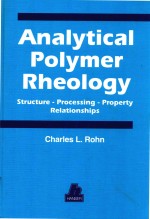图书介绍
Analytical polymer rheology structure-processing-property relationshipsPDF|Epub|txt|kindle电子书版本网盘下载

- Charles L. Rohn 著
- 出版社: Hanser Publishers
- ISBN:156990149X
- 出版时间:1995
- 标注页数:314页
- 文件大小:51MB
- 文件页数:328页
- 主题词:
PDF下载
下载说明
Analytical polymer rheology structure-processing-property relationshipsPDF格式电子书版下载
下载的文件为RAR压缩包。需要使用解压软件进行解压得到PDF格式图书。建议使用BT下载工具Free Download Manager进行下载,简称FDM(免费,没有广告,支持多平台)。本站资源全部打包为BT种子。所以需要使用专业的BT下载软件进行下载。如BitComet qBittorrent uTorrent等BT下载工具。迅雷目前由于本站不是热门资源。不推荐使用!后期资源热门了。安装了迅雷也可以迅雷进行下载!
(文件页数 要大于 标注页数,上中下等多册电子书除外)
注意:本站所有压缩包均有解压码: 点击下载压缩包解压工具
图书目录
Chapter 1 History of Rheology and Macromolecular Science1
Chapter 2 Principles of Mechanics12
2.1 Introduction12
2.2 Classical Mechanics12
2.2.1 Newton’s First Law of Motion13
2.2.2 Newton’s Second Law of Motion16
2.2.3 Newton’s Third Law of Motion19
2.3 Rotational Motion20
2.4 Angular Momentum22
2.5 Oscillatory Motion24
2.6 Natural Frequencies and Resonance26
Chapter 3 Stress and Strain30
3.1 Introduction30
3.2 Strain Tensor30
3.3 Continuum Concept33
3.4 Engineering Elasticity37
3.5 Viscosity41
3.6 Constitutive Equations43
Chapter 4 Gases47
4.1 Introduction47
4.2 Kinetic Theory47
4.3 Distribution of Molecular Velocities51
4.4 Molecular Effusion53
4.5 Transport Processes55
4.6 Molecular Diffusion58
4.7 Heat Transfer60
4.8 Principle of Equipartition of Energy61
4.9 Nonideal Gases63
4.10 Law of Corresponding States64
4.11 Intermolecular Interactions65
4.12 Relaxation Times69
4.13 Appendix70
4.13.1 Thermodynamics70
Chapter 5 Rubber76
5.1 Introduction76
5.2 Thermodynamics76
5.3 Tensile/Compression Stress-Strain Properties80
5.4 Distribution of Rubbery Chain Conformations Due to an External Stress82
5.5 Tensile Strength84
5.6 Rubber Products85
5.6.1 Tank Tread Problem89
5.6.2 Rack-and-Pinion Seal90
Chapter 6 Solids92
6.1 Perfect Crystals92
6.2 Imperfect Crystals104
6.3 Polymeric Crystals107
6.4 Semicrystalline Polymers109
6.5 Amorphous Solids111
6.6 Oriented Polymers111
Chapter 7 Fluids and Polymer Solutions117
7.1 Introduction117
7.2 Free-Volume (Hole) Theory118
7.3 Polymer Solutions121
7.4 Gel Permeation Chromatography123
7.5 Rouse Model125
Chapter 8 Polymer Melts130
8.1 Introduction130
8.2 Shear Rate and Frequency Dependence of Viscosity130
8.3 Shear Rate and Frequency Dependence of Elasticity135
8.4 Temperature Dependence of Viscosity141
8.5 Extensional Viscosity: Melt Tension and Draw Down143
8.6 Reptation Theory (Tube Model)148
Chapter 9 Phase Changes and Transitions152
9.1 Introduction152
9.2 First Order Transitions152
9.3 Crystallization and Melting154
9.4 Homopolymers156
9.5 Copolymers160
9.6 Glass Transition171
9.7 Transition Region174
9.8 Secondary Transitions180
9.9 Modulus-Temperature Curves183
Chapter 10 Suspensions189
10.1 Introduction189
10.2 Viscoelasticity of Suspensions189
10.3 Electrostatic Interactions193
10.4 Steric Interactions195
10.5 Polymer Blends196
10.6 Compatible Blends197
10.7 Incompatible Blends197
10.8 Block Copolymers199
10.9 Interpenetrating Polymer Networks199
10.10 Filled Plastics201
10.11 Phase Separation and Storage Stability202
10.12 Flow and Leveling204
10.13 Flow and Sagging205
Chapter 11 Linear Viscoelasticity209
11.1 Introduction209
11.2 Maxwell Model209
11.3 Boltzmann Superposition Principle210
11.4 Creep Properties212
11.5 Stress Relaxation Properties217
11.6 Dynamic Mechanical Properties218
Chapter 12 Rheological Testing222
12.1 Introduction222
12.2 Principles of Rheological Measurements223
12.2.1 Strain Dependence224
12.2.2 Frequency (Rate) Dependence224
12.2.3 Temperature Dependence225
12.2.4 Temperature-Frequency Dependence227
12.3 Fluids Testing227
12.3.1 Effusion of Gases Experiment227
12.3.2 Capillary Viscometer228
12.4 Experimental Measurements of Fluids234
12.5 Rotational Viscometers236
12.6 Solids Testing239
12.6.1 Statics239
12.6.2 Tensile Testing240
12.6.3 Compressive Testings241
12.6.4 Flexural Testing243
12.6.5 Torsional Testing247
12.6.6 Impact Testing249
12.6.7 Tear Testing251
12.7 Oscillatory Testing251
Chapter 13 Polymer Fabrication and Properties256
13.1 Introduction256
13.2 Extrusion258
13.2.1 Extrusion Quality261
13.2.2 Extruder Dies264
13.3 Output Rates264
13.3.1 Die Swell265
13.3.2 Haze and Gloss of Films272
13.3.3 Toughness of Blown Films274
13.4 Injection Molding278
13.5 Using Rheology to Predict Long-Time Durability of Plastic Products278
13.6 Physical Aging279
13.7 Using Rheology to Predict Toughness of Plastic Products280
13.8 Impact Strength281
13.9 Summary283
Chapter 14 Yielding and Fracture286
14.1 Introduction286
14.2 Theoretical Strength286
14.3 Yielding Behavior288
14.3.1 Amorphous Polymers288
14.3.2 Semicrystalline Polymers290
14.4 Fundamentals of Fracture Mechanics293
14.4.1 Hooke’s Law-Lattice Energy Theory298
14.4.2 Free Volume Theory299
14.4.3 Proof of Theory300
Index307